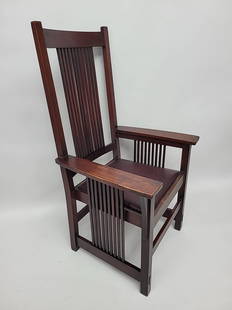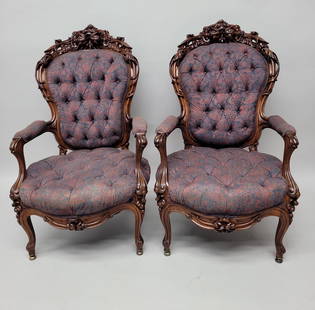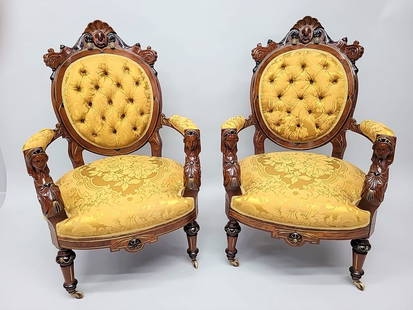
A PAIR OF FINE HUANGHUALI HORSESHOE BACK ARM CHAIRS,
Similar Sale History
View More Items in BergeresRelated Bergeres
More Items in Bergeres
View MoreRecommended Chairs
View More








Item Details
Description
A PAIR OF FINE CHINESE HUANGHUALI HORSESHOE BACK ARM CHAIRS, QUANYI.
With sweeping crest rail terminating in out swept hooks above shaped spandrels, all above the curved splat carved with beaded spandrels, gracefully curved standing stiles, and the rear posts, the hard mat seat presented beautifully with several 'ghost faces' panel set within the beaded, rectangular frame above shaped, beaded aprons and spandrels carved in the front with a conjoined leafy scroll, and plain, shaped aprons and spandrels on the sides and rear, the legs joined by stepped stretchers and the foot rest above plain, shaped aprons. Showing lustrous patina, several "ghost faces" all over the surface and rails.
Dimension(each): 39-5/8" H x 26" L x 24" D
LOT NOTES
The Chinese name for this type of chair, quanyi, is literally translated as 'chair with a circular back' or 'circle chair'. During the Song dynasty (960-1279) this form was known as kaolaoyang, which refers to a large round basket made from split bamboo. The English name for this form, however, refers to the overall shape of the back and arm rests, which resembles a horseshoe. Wang Shixiang and Curtis Evarts have suggested that the horseshoe-back armchair emerged simultaneously with other examples of high-back chairs during the Tang (618-907) and Song (960-1279) dynasties. See, Wang Shixiang and Curtis Evarts, in Masterpieces from the Museum of Classical Chinese Furniture, Chicago, 1995, p. 56, for a further discussion of the form.
An illustrated early example of the horseshoe-back chair in a woodblock print is included in the Lu Ban Jing (Classic of Lu Ban) but is utilized as a sedan-chair. (Fig. 1) The Lu Ban Jing (Classic of Lu Ban) is a Ming dynasty carpenter's manual that contains a significant amount of information describing the forms of popular furniture during that era. However, the text and its importance go far beyond that, as described by Craig Clunas in "Klaas Ruitenbeek's u Ban Jing," Journal of The Classical Chinese Furniture Society, Winter, 1993, pp. 30-32. Clunas explains that the Classic of Lu Ban "is a carpenter's manual, dealing not only with the technical aspects of building construction and of furniture-making, but with what might broadly be called the ritual and magical aspects of the craft."
The crest rail of this type of chair also ingeniously and elegantly functions as the armrest. Wang Shixiang explains in, Connoisseurship of Chinese Furniture, vol. I, Hong Kong, 1990, p. 43, that the "crest rail is made of several sections which comfortably support both the arm and the upper arm. The crest rail is constructed from three or five segments. A three-section crest rail is called a sanquan, a five-section one is called a wuquan. The three-section crest rail requires two fewer joints but requires larger members because of the wider curve." The crest rail of the present pair of chairs is constructed from five segments. For a detailed description and explanation of the sophisticated joinery utilized by the Chinese craftsmen to construct the curved rails of the elegant and graceful horseshoe-back armchair, see Curtis Evarts, "Continuous Horseshoe Arms And Half-Lapped Pressure Peg Joins," Journal of The Classical Chinese Furniture Society, Spring, 1991, pp. 14-18.
Several examples of similar HuangHuaLi horseshoe-back armchairs have been published including a larger pair (41 in. high) in the Minneapolis Institute of Arts, illustrated by Robert D. Jacobsen and Nicholas Grindley in Classical Chinese Furniture, Minneapolis, 1999, pp. 60-61, no. 12, and a slightly larger example (39 in. high) illustrated by Wang Shixiang and Curtis Evarts, Masterpieces from the Museum of Classical Chinese Furniture, Chicago, 1995, p. 56-57, no. 26, which was subsequently sold at Christie's, New York, 19 September 1996, lot 99.
With sweeping crest rail terminating in out swept hooks above shaped spandrels, all above the curved splat carved with beaded spandrels, gracefully curved standing stiles, and the rear posts, the hard mat seat presented beautifully with several 'ghost faces' panel set within the beaded, rectangular frame above shaped, beaded aprons and spandrels carved in the front with a conjoined leafy scroll, and plain, shaped aprons and spandrels on the sides and rear, the legs joined by stepped stretchers and the foot rest above plain, shaped aprons. Showing lustrous patina, several "ghost faces" all over the surface and rails.
Dimension(each): 39-5/8" H x 26" L x 24" D
LOT NOTES
The Chinese name for this type of chair, quanyi, is literally translated as 'chair with a circular back' or 'circle chair'. During the Song dynasty (960-1279) this form was known as kaolaoyang, which refers to a large round basket made from split bamboo. The English name for this form, however, refers to the overall shape of the back and arm rests, which resembles a horseshoe. Wang Shixiang and Curtis Evarts have suggested that the horseshoe-back armchair emerged simultaneously with other examples of high-back chairs during the Tang (618-907) and Song (960-1279) dynasties. See, Wang Shixiang and Curtis Evarts, in Masterpieces from the Museum of Classical Chinese Furniture, Chicago, 1995, p. 56, for a further discussion of the form.
An illustrated early example of the horseshoe-back chair in a woodblock print is included in the Lu Ban Jing (Classic of Lu Ban) but is utilized as a sedan-chair. (Fig. 1) The Lu Ban Jing (Classic of Lu Ban) is a Ming dynasty carpenter's manual that contains a significant amount of information describing the forms of popular furniture during that era. However, the text and its importance go far beyond that, as described by Craig Clunas in "Klaas Ruitenbeek's u Ban Jing," Journal of The Classical Chinese Furniture Society, Winter, 1993, pp. 30-32. Clunas explains that the Classic of Lu Ban "is a carpenter's manual, dealing not only with the technical aspects of building construction and of furniture-making, but with what might broadly be called the ritual and magical aspects of the craft."
The crest rail of this type of chair also ingeniously and elegantly functions as the armrest. Wang Shixiang explains in, Connoisseurship of Chinese Furniture, vol. I, Hong Kong, 1990, p. 43, that the "crest rail is made of several sections which comfortably support both the arm and the upper arm. The crest rail is constructed from three or five segments. A three-section crest rail is called a sanquan, a five-section one is called a wuquan. The three-section crest rail requires two fewer joints but requires larger members because of the wider curve." The crest rail of the present pair of chairs is constructed from five segments. For a detailed description and explanation of the sophisticated joinery utilized by the Chinese craftsmen to construct the curved rails of the elegant and graceful horseshoe-back armchair, see Curtis Evarts, "Continuous Horseshoe Arms And Half-Lapped Pressure Peg Joins," Journal of The Classical Chinese Furniture Society, Spring, 1991, pp. 14-18.
Several examples of similar HuangHuaLi horseshoe-back armchairs have been published including a larger pair (41 in. high) in the Minneapolis Institute of Arts, illustrated by Robert D. Jacobsen and Nicholas Grindley in Classical Chinese Furniture, Minneapolis, 1999, pp. 60-61, no. 12, and a slightly larger example (39 in. high) illustrated by Wang Shixiang and Curtis Evarts, Masterpieces from the Museum of Classical Chinese Furniture, Chicago, 1995, p. 56-57, no. 26, which was subsequently sold at Christie's, New York, 19 September 1996, lot 99.
Buyer's Premium
- 24% up to $50,000.00
- 21% up to $1,000,000.00
- 18% above $1,000,000.00
A PAIR OF FINE HUANGHUALI HORSESHOE BACK ARM CHAIRS,
Estimate $2,000 - $3,000
10 bidders are watching this item.
Shipping & Pickup Options
Item located in Marietta, GA, usSee Policy for Shipping
Payment

Related Searches
TOP






























![Pair of Mid-Century Modern Bentwood Armchairs: In the manner of Shelby Williams with inlaid horseshoe backs around upholstered cushions. Unmarked. [28 1/2 x 22 x 21 inches]. In overall good condition aside from light scuff and wear to frames.](https://p1.liveauctioneers.com/1221/313421/167929639_1_x.jpg?height=310&quality=70&version=1703011842)


![Pair of Modern Bentwood Armchairs: Pair of modern bentwood armchairs in the Chinese taste, with horseshoe yoke backs. [33 1/2" H x 22 1/4" W x 22" D]. Scattered scuffs, marks and wear.](https://p1.liveauctioneers.com/1221/322565/173754511_1_x.jpg?height=310&quality=70&version=1710860655)













































